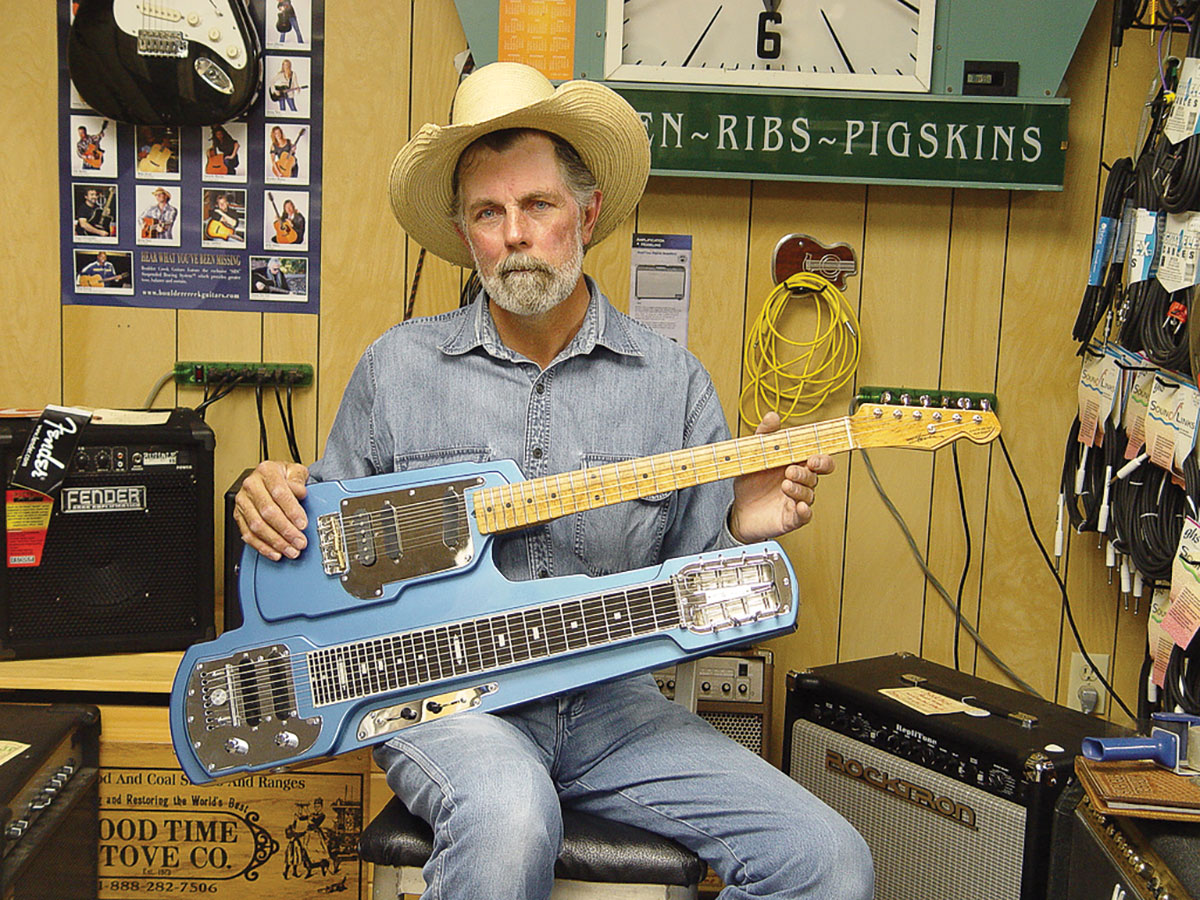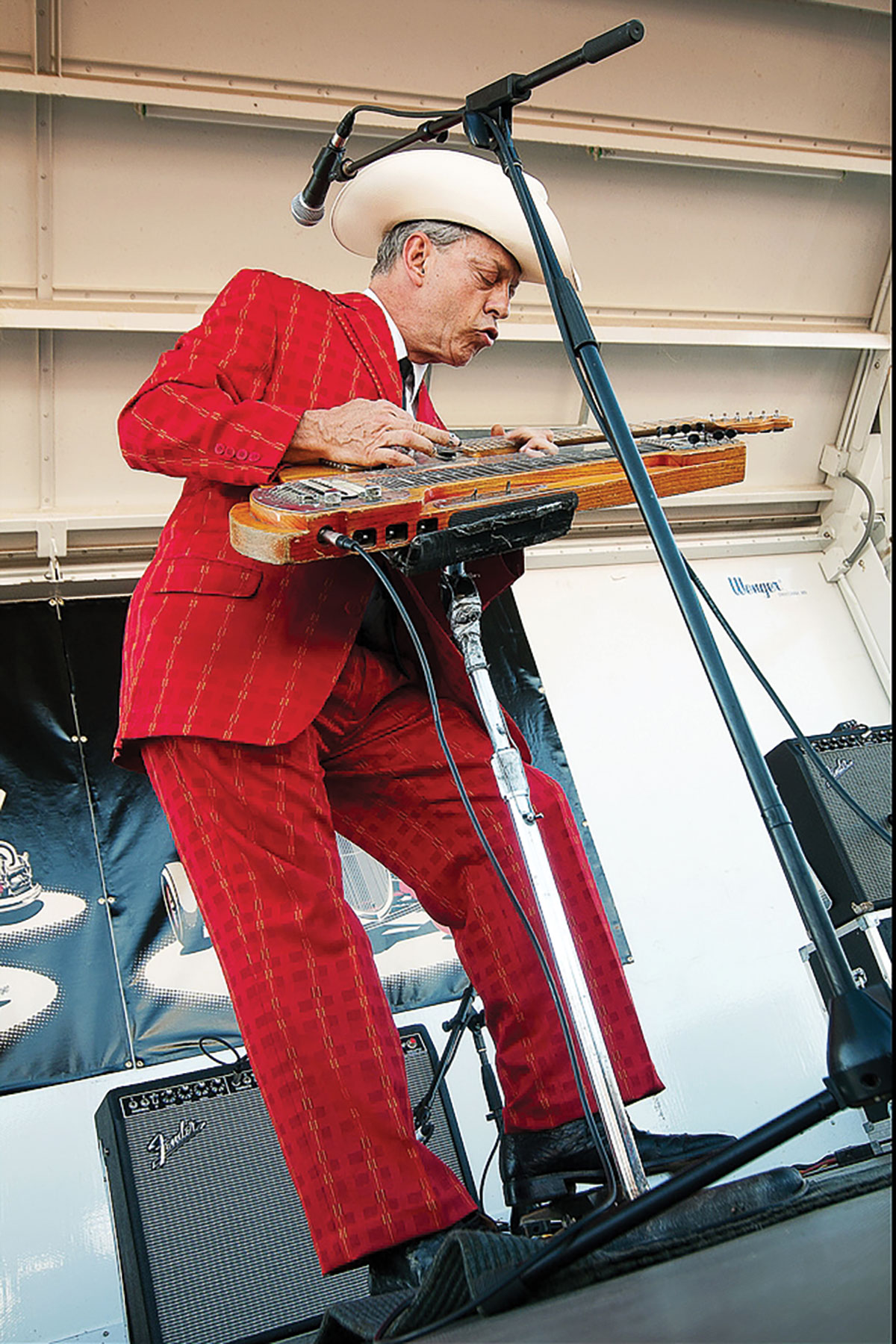
The first thing you will notice when Junior Brown takes the Coach House stage Friday night is the impeccable, pressed suit and tie under his pristine cowboy hat.
The next thing you will notice is the unusual stringed instrument on a stand the Austin, Texas-based artist will amble up to. Legend has it the Guit-Steel, as he calls the electric guitar/lap steel guitar hybrid, came to him in a dream.
“A long time ago, I worked up in my mind a whole cartoon video of him walking around in his pajamas with two guitars,” says Michael Stevens, the luthier who helped turn Brown’s dream into a reality.
Brown and his wife/manager/rhythm guitarist, Tanya Rae, long ago settled in Austin, where they and their band took up a weekly residency at the Continental Club. Stevens crossed their path as he had a “comedy band” that would also play in what is billed as “the granddaddy of all local music venues.” They’d even talked about possibly doing a musical project together, but that seemed to have fizzled out.
Stevens had been a luthier since 1968, left the business in 1974 to train show horses, then went back to making stringed instruments five years later—as Austin’s live-music scene was blazing. His specialty was double-necked guitars, boasting that the one he made out of a Stratocaster “won five Grammys” for pop star Christopher Cross. “He played that for a long time,” Stevens says. “You can look it up.”
Of course, when most people think of double necks, they picture the Gibson EDS-1275 that Jimmy Page used in live Led Zeppelin shows. In the recording studio, the legendary guitar slinger could play an amplified acoustic for the intro to “Stairway to Heaven,” put it down as the tape stopped, then pick up his electric for the blazing solo that pretty much lasts the entire second half of the mega-hit. Making that change would be too cumbersome onstage; the EDS-1275 allows him to seamlessly switch between the bottom, acoustic, six-string neck and the top 12-string electric.
Brown’s predicament was the country-fried version of Jimmy’s.
“Junior was playing at Hut’s Hamburgers, a joint with live music in Austin, with Tex Thomas and the Danglin’ Wranglers,” Stevens remembers. “Back then, he was playing a little Gibson 33. He’d switch to the steel guitar [in the middle of a song], but he’d bang into it with the Gibson that was on a strap around his neck.”
Plenty of other steel-guitar players used the instrument facing up on a stand, as though it were a keyboard, and then, while seated, they would lift a traditional guitar from their laps, Stevens notes, but Brown wanted to play both the steel and electric while standing up. “At some point, he kind of joked that he wanted to have the guitars together,” Stevens says. “When his dream came, I wasn’t there, fortunately, in bed with him—although we got in bed together later.”
Seriously, it was a combination of Stevens’ reputation with double necks and the musicians knowing each other from the Continental Club that finally did lead to a musical project together. But instead of a song or show, it was the Guit-Steel. “He had the concept for this thing,” Stevens concedes of Brown. “I never would have thought of it.”
The first version the partners created involved two Fenders: a Stringmaster eight-string steel guitar and a “really cheap” Bullet six-string electric guitar. Brown instructed Stevens to cut the “horn” off the guitar, which the luthier did before gluing it to the steel guitar’s frame. “Yuck, it sounds awful,” he recalls saying of the first sounds to come out of the thing. “It took a while to get the bugs out.”
Brown insisted the instrument have the proper “balance.” Strings were moved around, the steel side’s shelf was monkeyed with, and the overall thickness was adjusted to compensate for the positions Brown’s hands would have to be in to effortlessly switch between guitars. Giant rubber bands kept the two guitars together while spots for each fretboard were finalized. Holes were drilled, foam rubber was added, and Stevens even invented a “squishy” part whose “nasty name . . . we can’t put in the paper.”
Guit-Steel is Not the Only Invention Junior Brown Dreamed Up
Finally, “Big Red,” the first finished Guit-Steel, was created, but the work was not over for Brown. “Then he had to learn how to play it,” says Stevens in a tone dripping with deadpan. The Guit-Steel Brown plays now has been further refined. He plucks, strums and slaps the electric guitar as he would any other, but when he changes over to the steel side, the electric’s strings face the floor.
Brown honored his unique instrument by titling his 1993 Curb Records album Guit With It, but he has said the Guit-Steel has done more than allow him to switch instruments mid-song. He credits it with further making his ferocious playing, bottomless-barrel vocalizing and clever songwriting truly one-of-a-kind.
Along the way in the Guit-Steel development, a stand was added because, otherwise, there were some notes and chords Brown could not play, according to Stevens. Also, because it weighed about 13 pounds, it was doing a number on Brown’s back. The solution only led to more opportunity for Stevens, who says, “I ended up being in the guitar-stand business.”

Today, Alpine, Texas-based Stevens Electrical Instruments will build a Guit-Steel for $14,500, with additional charges for any variations. The thrifty will be pleased to know a flight case from Keal Cases of Round Rock, Texas, as well as a Guit stand that fits a standard mic stand are included at no additional cost.
Stevens says he has filled about a half-dozen orders over the years, and he fondly recalls sending a made-to-order Guit-Steel to an Army Post Office address in Japan. But there is little chance whoever plays it can impress him the way the original dreamer does.
“He’s a magician at it,” says Stevens of Brown. “It’s awesome watching him.”
Junior Brown performs at the Coach House, 33157 Camino Capistrano, San Juan Capistrano, (949) 496-8930; thecoachhouse.com. Fri., 8 p.m. $22. All ages. You can reach Stevens Electrical Instruments via stevensguitars.com.

OC Weekly Editor-in-Chief Matt Coker has been engaging, enraging and entertaining readers of newspapers, magazines and websites for decades. He spent the first 13 years of his career in journalism at daily newspapers before “graduating” to OC Weekly in 1995 as the alternative newsweekly’s first calendar editor.


Matt,
Just found this part, duh.
Thanks
MS
Hey. Too bad about Junior’s Guit-Steel being stolen. There are evidently not many of these around, so it should stand out wherever it ends up. I believe he will eventually get it back– hope so. Is his the original?
I met you in Austin way back– 80s I guess. My girlfriend was with me and we came to see you to help me modify the bridge on my ’53 Les Paul, which had been changed to have a tunomatic and stop tailpiece, You know, that neck angle was kind of low back then. Afterwards, you took us to Antones to hear some good music. It was Awesome. Thanks again for that! Hope to see you again one day.
Your writing is truly exceptional. illplaywithyou
Your insights are always on point. hot nude cams